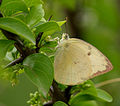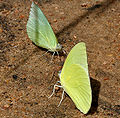- Catopsilia pomona
-
"Emigrant butterfly" redirects here. For the Mottled Emigrant, see Catopsilia pyranthe.
Catopsilia pomona 
Scientific classification Kingdom: Animalia Phylum: Arthropoda Class: Insecta Order: Lepidoptera Family: Pieridae Genus: Catopsilia Species: C. pomona Binomial name Catopsilia pomona
Fabricius, 1775Synonyms Catopsila crocale
The Common Emigrant or Lemon Emigrant (Catopsilia pomona) is a medium sized pierid butterfly found in Asia and parts of Australia. The species gets its name from its habit of migration. Some early authors considered them as two distinct species Catopsilia crocale and Catopsilia pomona.[1]
Contents
Description
See glossary of Lepidopteran terms for terminology usedThe species has pale and dark morphs in Australia.[2] The form crocale has the antennae black and the form pomona has the antennae pinkish or red. The development of these forms has been linked to photoperiod and temperature during growth. [3][4]
The following description is from Bingham for Catopsilia crocale: The upperside of the male is chalky-white, sometimes with a more or less broad and clearly defined basal sulphur-yellow area on both fore and hind wings; this sulphur-yellow colour is at times diffused over the whole surface of the wings, though generally it becomes paler towards the terminal margins. For the fore wing, the whole, or sometimes only the apical half, of the costa narrowly black, this color widened out irregularly at the apex; termen widely black at the apex, the colour narrowed posteriorly. This border in some specimens almost reaches the tornus, in others terminates above vein 4; occasionally it is continued posteriorly by a series of block dots at the apices of the veins. Hind wing: generally uniform, unmarked, some specimens bear minute black dots at the apices of the veins.
On the underside the groundcolour is very variable, with white with a slight to strong ochraceous tinge, greenish white or sulphur-yellow. The fore wing is typically without markings, in some specimens with a patch of sulphur-yellow on either side of base of median nervure, in the very yellow examples the tornal area is often widely greenish white, in others (Catopsilia catilla, Cramer) it bears a spot variable in size on the discocellulars. This spot has a pearly centre and an outer reddish line. Many specimens have an irregular angulated narrow discal reddish line (the colour varies in intensity) that runs from the costa obliquely outwards to vein 7, and then obliquely inwards to vein 2, though this line is often absent in specimens that bear the discocellular spot; apex and termen sometimes very narrowly reddish. The hind wing is typically uniform, without markings; in var. catilla there is a single small spot at the end of the cell similar to that on the fore wing, sometimes this spot is much larger with a narrow outer reddish ring, sometimes it is accompanied by a similar spot at base of interspace 5; when two spots are present they may be entirely separate, or their outer rings may coalesce; again, some specimens have a highly irregular discal reddish line (often reduced to a series of minute spots) that extends from the costa to vein 1; finally, the majority of specimens have a series of minute red terminal dots at the apices of the veins.
 Female in Hyderabad, India
Female in Hyderabad, India
On the female upperside the ground-color varies as in the male, but sometimes it is chalky white at the bases of the wings, with the terminal margins more or less broadly sulphur-yellow. Fore wings always with a round, occasionally quadrate, black discocellular spot variable in size; in some specimens the costa is black only towards the apex of the wing, in others broadly black throughout and opposite the apex of cell so widened out as to touch the discocellular spot. In lightly marked specimens in addition to the discocellular spot, there is only an irregular terminal black band dentate inwardly and widest at the apex of the wing; in others there is in addition a more or less diffuse highly curved macular postdiscal band that extends from the costa obliquely outwards down to vein 7, where it often touches the terminal black band, and thence is continued downward and slightly inclined inwards to interspace 1, getting gradually paler and fainter posteriorly. Hind wing: a series of terminal inter-spacial black spots that vary in size, and in the dark forms coalesce into a terminal black band.
The underside varies from white with a light yellowish sometimes ochraeeous tinge to deep chrome-yellow; markings as in the male but still more variable; in var. catilla the spot at the apex of the cell in both fore and hind wings is enlarged into a large reddish blotch, the similar spot on tho hind wing is sometimes so enlarged as to occupy the apex of the cell, the basal two-thirds of interspaces 4, 5 and 6, and the middle third of interspace 7; in some specimens it is continued posteriorly in a series of obscure lunules to interspace 1a. Antennae red, obscurely dotted with black, palpi and head above red, thorax clothed with long yellow, sometimes greenish hairs, abdomen pale yellow; beneath: palpi and thorax pale to dark yellow, abdomen white.[5]
Lifecycle
The eggs of the butterfly are laid in small batches on various species of plants including several Cassias.
Other host plants include Butea monosperma, Cassia fistula, Bauhinia spp., Pterocarpus indicus, Senna alata and Sesbania species.[6]
The larva of is described by Bell as "The head is round , green, the clypeus edged with brown, covered with small shiny black tubercles which... do not hide the colour of the head; the anal flap is rounded, but looks square at the extremity, and is covered with rows of small black tubercles... of which only the row along the spiracular line is conspicuous. The spiracles are oval, shiny and white. The colour is green with a spiracular white band touched with bright yellow on segments 2-5, and these segments, especially 3 and 4, are distinctly flanged on the spiracular line.[5]
"The pupa has the dorsal line of the thorax absolutely parallel to the longitudinal axis of the pupa for two-thirds of its length, consequently the hinder part junt before the margin is perpendicular to this part, it is raised suddenly but very slightly above the front margin of segment 4, and the front end of this parallel dorsal line is at an angle, and a sharpish angle, with the front slope of the thorax .... the cremaster is distinctly bifid at the extremity, and has some shiny, very stout, black, suspensory hooks dorsally as well as at the extremity. There is a dorsal rugose black tip to the snout terminating the head, which snout is cylindrical in its apical half; there is no black line round the eye and there is a dark green-blue dorsal line which is yellow on the thorax as well as the supra-spiracular yellow line."[5]
Habits, behavior, views
-
Female on Catunaregam spinosa (Mountain Pomegranate) in Keesara, Rangareddy district, Andhra Pradesh, India (next two pictures)
-
Male on Canthium coromandelicum in Keesara, Rangareddy district, Andhra Pradesh, India.
-
Female in Hyderabad, India.
-
Female in Hyderabad, India.
-
Female on a Bougainvillea species in Kolkata, West Bengal, India.
-
Female in Hyderabad, India
-
Male in Hyderabad, India
-
Female on Jatropha panduraefolia in Kolkata, West Bengal, India
-
Female in Kolkata, West Bengal, India
-
Male in Kolkata, West Bengal, India
-
on Singapur cherry Muntingia calabura in Hyderabad, India
-
Mud-puddling in Narsapur, Medak district, India (next six pictures)
References
- ^ Evans, W.H. (1932) The Identification of Indian Butterflies. (2nd Ed), Bombay Natural History Society, Mumbai, India
- ^ Grund, R. Catopsilia pomona datasheet Accessed:September 2006
- ^ Rienks, J.H. (1985) Phenotypic Response to Photoperiod and Temperature in a Tropical Pierid Butterfly. Australian Journal of Zoology 33(6) 837 - 847
- ^ Sevastopulo, D. G., "Seasonal forms of Catopsilia spp." Journ. Bombay Nat. Hist. Soc, vol. 49:570
- ^ a b c Bingham, C. T. (1907) Fauna of British India. Butterflies. Volume 2
- ^ Gaden S. Robinson, Phillip R. Ackery, Ian J. Kitching, George W. Beccaloni and Luis M. Hernández. HOSTS - a Database of the World's Lepidopteran Hostplants [1] Accessed September 2006
See also
Categories:- Coliadinae
- Lepidoptera of Australia
- Butterflies and moths of Asia
- Butterflies of India
- Insects of Pakistan
-
Wikimedia Foundation. 2010.

























